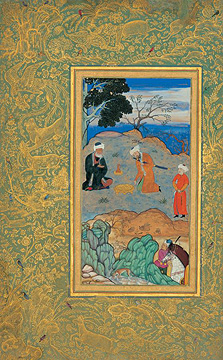Image Resource Bank
Image Gallery |  8 of 15
8 of 15 
Ascetic Advice
This is a miniature by the famous Persian painter Behzad (d. between 1536 and 1537 CE).
Under the patronage of the descendants of the great Turko-Mongolian conqueror Tamerlane, the city of Herat (in modern-day Afghanistan) became a great center of learning, the arts, and culture in the 15th century. The city was home to poets like the Persian poet Jami (d. 1492), and Ali Shir Nava’i (d. 1501), a poet who refined Chaghatay Turkish—a form of Turkish related to modern Uzbek—into a great poetic language. The city at the time also was home to many great visual artists, like calligraphers and architects, but most famously miniature painters, the most celebrated of which was Behzad. Behzad’s paintings have been both greatly admired and highly prized from his own day down to the present. He is noted for the crispness of his figures and his fine attention to detail and color, as well as his skill in capturing the mood of the painting. In fact, Behzad was so well known in his own time that when the Safavids conquered Herat at the beginning of the 16th century, they kept the painter alive and moved him to their own court in Tabriz.
The scene depicts a prince sitting at the feet of wandering ascetic or dervish, seeking wisdom—a motif widespread within classical Middle Eastern art and literature.
Name: Ascetic Advice
Material: Ink and paint on paper
Size: Unknown
Date: Early 16th century CE
Place of Origin: Tabriz, Iran
Location: Tehran Museum of Contemporary Art, Iran
Source and Registration#:
Wikimedia ![]() , (accessed February 5, 2010).
, (accessed February 5, 2010).

 Michael Sells
Michael Sells
John Henry Barrows Professor of Islamic History and Literature, Divinity School, The University of Chicago




